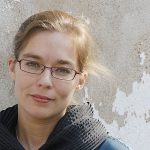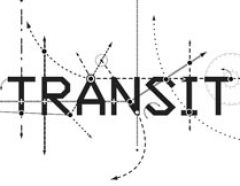Here is the latest installment of TRANSIT’s ComposerViews series. Enjoy!

ComposerViews (CV): Hi, Žibuoklė. Thank you so much for agreeing to be a part of TRANSIT’s ComposerViews series. And additional thanks for being the co-curator for our upcoming DoubleBill concert focusing on Lithuania. We have really had a great time getting to know this music and are looking forward to the concert!
One of our interests as an ensemble is exploring the different music scenes in various communities around the world. As a composer who has lived, done residencies, and worked across Europe and North America, what do you think are some of the unique aspects of the new music scene in Lithuania?
Žibuoklė Martinaitytė (ZM): I am honored to contribute to TRANSIT’s initiative, “DoubleBill,” and to have a rare opportunity to present Lithuanian music to New York audiences.
Lithuania is a small country of about 3 million inhabitants, but proportionally, we have a high number of composers for its size! The new music scene is quite vibrant and varied there although in its very essence, it remains somewhat homogenous which is perhaps natural considering the scale of the country and lack of cultural diversity. For a long time there has been a dominant tendency towards minimalism that came not so much as an influence from outside, but rather was rooted in our own ancient musical form called sutartinės. Lithuanian minimalism branched into multiple metamorphoses such as “sacred minimalism,” superminimalism, post-minimalism etc. Currently in addition to a representation of a larger variety of styles, many composers are often using a more complex musical language within the aesthetics of simplicity and clarity of form fundamental to minimalism.
Another thing that stands out for me as a unique feature of Lithuanian new music is its distinct harmonic flavor. The same way as when walking on the streets of New York, one can often guess the cultural heritage of people by looking at their facial features and color of eyes, I can sense a particular “sonic aroma” that is innate to Lithuanian music. It has mostly to do with the choices of pitches and preferred intervals that are closely related to the speaking intonations of the language. This emphasis and care for harmony reflects the innermost depths of life and introspection that is expressed with a discernible quality of melancholic and lyrical hues. Harmony becomes a way to connect to the listeners and channel through creative intentions even when other musical parameters are overly elaborated and complex. As though harmony hooks up the brain of the listener and once that is achieved, you can tell any musical story you wish however disparate or intolerable it might be.
CV: New York is often thought of as a melting pot, wherein cultures from all over the world are jumbled up in new ways in close quarters. A parallel vision might also make sense for New York’s new music scene. Lithuania seems remarkable for having retained such a strong and individual cultural heritage throughout a long history of occupations, wars, and alliances. Do you feel that this cultural perseverance has impacted the country’s musical culture as well?
ZM: Yes. In the past, Lithuania has managed to retain its cultural identity to a large degree. It was our strength that helped us survive especially through the Soviet occupation times. It’s no wonder that for this period the tendency to cling to one’s cultural identity remained very strong. Musical culture was impacted as it was quite insular with limited exposure to other cultures and influences and therefore remained intact. The globalization and age of information that coincided with Lithuania re-gaining its independence has left its mark too. More and more young composers are studying abroad, mostly in other European countries and thus absorbing new influences. As is the case with some composers presented at the “DoubleBill” series – Ramūnas Motiekaitis studied in Norway and completed his doctoral degree in Finland and Japan, Albertas Navickas – in France.
CV: The United States is a huge country and New York is a huge city. As someone who has lived in New York for some time now, but also continues to spend a lot of time in Lithuania, I wonder if you feel that this simple difference of size affects the way a musical community functions? For example, it’s entirely possible for composers in New York to be totally unaware of each other’s existence– would that be possible in Vilnius?
CV: In Lithuania it would be impossible not to have heard of another composer from the same community. Perhaps it is mostly related to the feasible size of the country and even a smaller circle of composers. This also applies to the commonly shared cultural points of reference – everybody gets the same intake of culture and music. Of course I am talking about live events and concerts that are happening in the country. The other side is individual cultural consumption that takes place via the Internet and here everybody tailors their own choices in a more unique way. In New York this individualized consumption of culture penetrates everyday life. So in that regard, the difference in size has an effect on how musical community functions. A larger place is a more fertile ground for unexpected connections and discoveries to take place whereas in a smaller community, it is easy to just stay with your preconceived ideas of how things are without ever having to break your concepts. On the other hand, a smaller musical community offers more support and opportunities for performing music, which is so vital for composers.
CV: In your music, rich instrumental colors and stark contrasts often result in a real intensity of expression. Do you think that expressing this level of intensity is central to your compositional voice or is it a result of your interest in certain timbres? Do you often begin working on a piece with a particular melodic or thematic motive in mind, or is it more common to begin with an idea of instrumental or sonic color?
ZM: I would say the emotional intensity of expression comes first and it has become central to my music. In the process of composing, I make decisions of how to direct the flow of energy and then I try to find ways to accomplish it through instrumental colors. The structural idea comes first and the realization of it follows. I usually find myself knowing the general atmosphere of the piece quite early in the process and then discovering appropriate musical means to match this inner mental image. Let’s say if I need some “ethereal or otherworldly” sonic quality in a particular spot, I hear subtle overtones in the high register or get some vague feeling of a sparse texture and then I look at my instrumental palette that I have at hand and see what combination of timbres would produce the desired effect.
CV: You studied piano before focusing primarily on composition, and a characteristic of many of your pieces now is the utilization of extreme registers or of highlighting instruments that often aren’t featured in soloistic roles. (I’m thinking especially of your piece Attention! High Tension! for tuba and piano.) Do you think that there might be some connection between your early study at the piano, an instrument with a very large range, and your interest in the use of extreme registers?
ZM: I’ve never thought of this in these terms and now your insightful question may have identified the causes that led me to the exploitation of the extreme instrumental registers. Being used to such a broad range of the piano, I was unconsciously trying to expand my sonic realm within given constraints that would encompass all the heights and lows of the sound spectrum. Another reason for that is perhaps a wish to explore the voice and color of an instrument that is less commonly heard. I’ve also noticed that when playing in extreme ranges, which in some cases is not very comfortable for the performers, there is a certain degree of tension arising and it adds the sought-after edginess to the overall emotional intensity.
CV: You have written extensively for orchestra but also for a wide and eclectic array of chamber instrumentations. How do you find that these relate to each other? Is it easy to go back and forth, or do you have fixed ideas about specific instrumentations?
ZM: It is a question of musical palette and a prism through which we view the world. You either get many colors with multitudinous possibilities of mixing them as it is with orchestral or large ensemble music, or you have only three or four instruments with still quite an incredible array of effects and gradations available. I am intrigued by the unusual combinations of timbres, which leads me to an untrodden path for a sonic journey. Orchestral music is mirroring the macrocosm – it breathes with every shade of every color and contains it all. Chamber music is in a way more focused as though you direct your gaze to one particular object like scientists or meditators do and through the understanding and dissemination of that one object, you unveil the inherent laws of the entire universe. It’s a matter of perspective, of the angle of perception. One is showing the forest in its full complexity and beauty and another – just one tree with all the intricate details. I do like switching back and forth between these modes of perception and applying to a macro level things that I’ve learned working on the micro-level of chamber compositions.
CV: From your perspective, as someone who maintains close ties with the music scene in Lithuania but who has also worked and studied in other musical communities around the world, how do you see Lithuanian new music developing in the future?
ZM: The tendency of globalization with a gradual dissolution of cultural and musical identity is affecting us all… small countries as well as big ones. It’s becoming harder to retain specificity of musical expression, which was quite natural and easy to do in the earlier pre-Internet times. On the other hand, it is very exciting to be witnessing unpredictable cultural hybrids and their creative outcomes appearing as Lithuanians are migrating more and more. As long as Lithuanians preserve their native tongue, which influences the inherent syntax and hidden logic of the music, it will retain some shade of cultural authenticity even if a little faded or distorted.
CV: Thanks so much for your time, and for this invigorating discussion! We have so enjoyed getting to know you and your music, and we can’t wait to premiere your piece, Gridlock, on June 23!
==============
To hear Žibuoklė’s music and the program of Lithuanian and New York new music that she has co-curated with TRANSIT, be sure to check out this concert:
DoubleBill Series:
Lithuania / NYC
June 23, 2016
Firehouse Space
8 PM
Featuring recent music from emerging composers including Žibuoklė Martinaitytė, Albertas Navickas, Lukrecija Petkutè, and Ramūnas Motiekaitis (LT); and Brooks Frederickson, Loren Loiacono, Daniel Wohl, and Leaha Maria Villarreal (NYC).
*Gridlock was commissioned by the Barlow Endowment for Music Composition at Brigham Young University.

